#the camera has to be at almost 180 degrees
Note
Jacob do not have a lore and background story? :(
[Oh yeah he do. You just have to know where to look...which is always at my place. *does some digging* Ah, here we go.]
You’re settling down in a suburban town in Texas, starting a new life for yourself. Lately, your mail has been getting sent to the wrong house and keeps ending up at your neighbor’s front door. Or at least, that’s what he told you.
Your polite neighbor Jacob has been returning your mail quite often lately. It’s almost like he wants to talk to you more...
Name: Jacob Alden
Age: Late 20s-Early 30s
Killer Type: Stalker, serial killer, yandere-esque
Hobbies: Collecting vintage things (mainly technology of that time), using old cameras and video tapes, watching movies (especially obscure films and B horror films), fishing, raising freshwater fish as pets, collecting things from his crush, stalking them, doing vulgar things with his crush’s objects and pictures…
Occupation: Stocker (haha it’s almost like a pun…a stalker whose a stocker…)
General Demeanor: Comes off as quiet and introverted, lacks some social cues, somewhat cynical and bitter, the “weird awkward grumpy guy no one really wants to talk to at work”
Demeanor around crush: VERY clingy and a complete 180 from his typical self, very talkative towards them and gives them his full attention, will shower them in affection to an uncomfortable degree.
Although he acts as if “This is what you want! This is what you need from me!” a lot of the things he does to his victim is more out of his own self-indulgence that he’s unaware of. He’ll still do SOME things his victim would ask for so he can spoil them (he can buy you things, if the trust is strong he may loosen your restraints so they hurt you less) but things like “Could you let me go?” are a huge no, and the more you complain, the more he gets closer to snapping.
“YOU UNGRATEFUL BITCH! LOOK AT HOW MUCH I’VE DONE FOR YOU! CAN’T YOU SEE HOW MUCH I FUCKING CARE ABOUT YOU??? …No….I should have known, you’re not the one for me…you don’t deserve this…you don’t deserve ME. YOU DON’T DESERVE MY LOVE. MY AFFECTION. MY PRAISE. YOU WASTED MY DAMN TIME!!!”
Yeah, a lot of his feelings are all in his head. If he thinks his crush isn’t “thankful” enough (or at all), he sees it as their fault rather than his own doing. Kidnapping someone against their will and doing bad things to them…Jacob believes what he’s doing is fine because “No no, they DO love me! Our hands touched when they handed me my money…a-and then we saw each other again at the park nearby! Well, they didn’t actually see me, but they were just playing hard-to-get! They DO love me, I just know it! We have a connection you wouldn’t understand, they are my SOUL MATE!”
111 notes
·
View notes
Text
baby steps // lance stroll
summary: headcanons i wrote at six in the morning because i woke up with an idea and wouldn’t let it go. alternately, lance and y/n bring their daughter to a race for the first time.
first of all, nobody thought that lance would be the first to have kids
some of the older drivers already had kids, but they were in their early thirties, or at least approaching that benchmark
everybody thought that lewis or daniel would be next to settle down
but nope. it was this fucking twenty something year old canadian boy
when ayla naomi strulovich was born, lance cried for hours
that was more than his wife cried during the whole ordeal
naturally, the man has separation anxiety, and started to hate leaving home to go race cars because he didn’t want to leave his two angels.
constant face time calls, following by joking mocking from some of the other drivers
ayla was three when lance and y/n finally agreed that she could go to a race
they started small, taking ayla to silverstone since it was only three hours away on a major highway
everybody on the paddock wants to spend time with ayla
enter best godfather sebastian
ayla just wants to chill with her uncle sebby, and sebastian is all too happy to give the three year old a tour of the aston martin motorhome
when ayla walks into the garage, the first thing she does is demand to see her grandfather
lawrence stroll was this james bond-villain type figure in the paddock, but his personality did a complete 180 degree turn when he was around his granddaughter
“he was never that soft on me” lance would grumble
to which y/n simply laughed before linking her arm with his as lawrence scooped ayla into his arms and started to show the little girl the car her father would be driving
“to be fair, he did cry at our wedding.”
“yes, but the two of us also cried at our wedding.”
“but i didn’t cry in front of you.”
“your eyes were puffy.”
“god damn it, lance.”
“language. our daughter is in the room.”
gentle and loving smack follows. “i hope your father wants to play babysitter tonight. you’re in for it later.”
raised eyebrow from lance
“oh really?”
when the driver’s parade rolls around, lance grins
“i want to bring ayla to the parade.”
y/n’s eyes go wide, mama bear instincts kicking in.
“lance, are you sure that’s safe? so many things could happen-”
lance squeezes her hands. “everything is going to be fine.”
begrudgingly, y/n agrees, and ayla is outfitted with soundproof headphones
ayla instantly becomes the star of the show
she’s in lance’s arms for the entire thing, waving at the crowd even though she doesn’t have a clue what’s happening.
the camera was almost always on the two of them
it didn’t matter how lance placed in the actual grand prix.
it would forever be his favourite because both of his angels were there
#f1 x reader#aston martin f1#lance stroll x reader#lance stroll#formula one x reader#headcanons#f1 imagine
600 notes
·
View notes
Text
Slam Dunk, panels and movement
(previously on the subject of comic panelling, animation and time)
I've been reading Slam Dunk after we had such a blast watching the movie.
And... as much as the film changed the tone of Slam Dunk from comedy to drama, I can really see where that incredibly sharp sense of choreography in the actual basketball scenes came from. Inoue's art rapidly gets really good from the start, but he really kicks it up a notch in the basketball scenes. He has a fantastic sense of how to convey motion, and communicate quite complex movements economically.

It's very animation-like in a way, showing key poses with a really clear relation to each other, creating anticipation poses and then presenting a surprise twist on them. it requires incredibly precise drawing to work.
Below I've written a little analysis on some example pages from the first proper basketball match. Shohoku are up against a school called Ryonan. They're getting their asses kicked. (Scans here are from Tensai Manga Project, they are pretty bad but it's all I have available in English.)
On this page, we see Rukawa (Shohoku #11) attempting to receive a pass...

Rukawa is stretching up to meet the ball, surrounded by negative space. The proximity of Uozomi looming behind him adds tension.
But we cut to a closeup of Sendo, who is Ryonan's star player, and then on the next page we keep the camera fairly close to where it was...
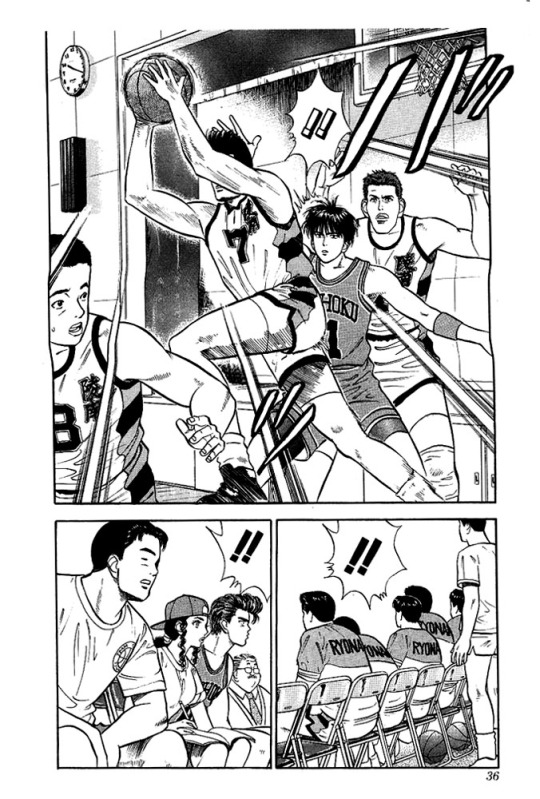
Sendō (Ryonan #7) jumps in and intercepts the pass. the fact that the other characters have barely moved communicates how quickly he must have moved, as well as the surprised expression of the other players, and this is underlined by reaction shots.
To convey motion in a drawing, which is inherently still, you have a number of tricks you can employ. Speed lines are well known, and Slam Dunk uses them to great effect, but posing is also incredibly important. If a character is balanced, we assume they're relatively still. If they're off-balance, it feels like we're seeing them mid-movement.
(This is pretty logical, because walking and running is a process of continually moving off-balance and catching ourselves before we fall, so we'll only tend to see off-balance poses in that context.)
Here, there's a strong diagonal movement across the panel with Sendō. The speed lines enter from bottom right, and lead up along the line of action, which cuts across the other characters. The movement is accentuated by the hatching, which follows the diagonal motion.
Another one of Inoue's favourite techniques is to show multiple poses within the same panel, a technique even more like animation. For example, here we have Uozomi (Ryonan #4) intercepting a pass...

We have two extreme poses in one panel. We have the arm stretched up, and the arm rotated almost 180 degrees, blurred with speed lines. The path of the ball is further indicated by a straight line, bouncing at the bottom of the panel; the onomatopoeia (バン ban) also reads diagonally along the same line. So you read the panel along that exact line: you register the arms, then you follow the line down and see the ball.
Uozomi is incidentally one of those yankii brick shithouse highschoolers, here he is meeting gori -

You can make a character look large and imposing by shooting them at a high angle and making their head small compared to their body. What's kinda funny to me is that the proportions of the characters seem very elastic - when they're on the basketball court they're relatively natural, but in other scenes they'll be super exaggerated like this.
Anyway, returning to basketball.. this two page spread provides a great example of the 'two poses in one panel' trick:

Sendō is jumping as if to score, and Rukawa is jumping to intercept him - note the off-balance midair poses here, the centre of gravity is not central for either character - but at the last second Sendo passes back to another player. This is conveyed by drawing Sendo's arm twice - again, at both extremes of the throwing motion - and drawing the ball twice, connected by speed lines.
Once again, we follow up the big splash panel with reaction shots, which help sell that something impressive just happened.
A similar example from the beginning of chapter 29:

The first panel shows Sendo jumping to score. The second panel shows Rukawa's hand appearing to intercept it. Then, panel 3 shows Sendō passing to a teammate. We have Sendō and Rukawa suspended in midair poses. Sendō isn't looking where he's throwing the ball, which helps convey that it's a rapid flick. The other characters are in running poses - this is the passing position of the run, which has the most asymettric silhouette in the front view.
In this page, Rukawa attempts to get the ball from Sendo...
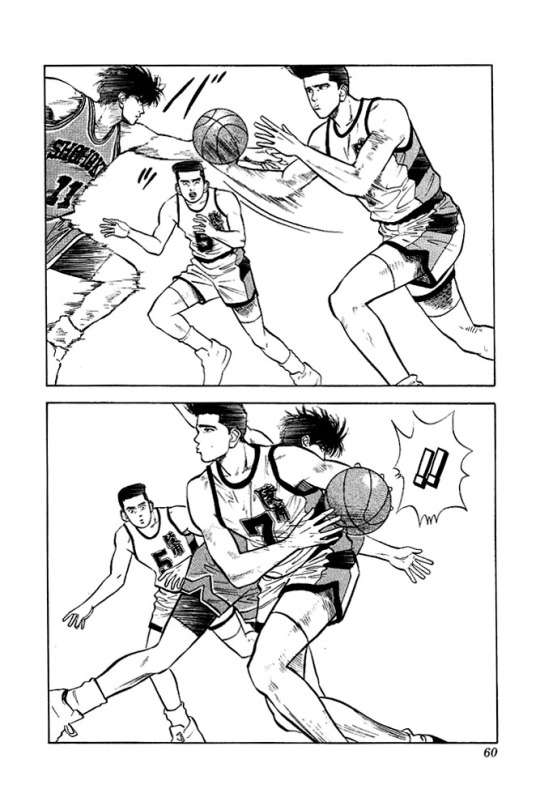
The second panel is shot from the same angle and shows Rukawa and Ryonan #5 back there in almost but not quite identical poses, while Sendō has flipped the ball across his body. Rukawa and Sendo have both moved a fair distance, while #5 has barely moved. The differences communicate speed: both Rukawa and Sendō are moving fast, but Sendō has moved faster. Once again, Sendō is not looking where he moved the ball - this helps sell the casualness of the movement.
All of this so far uses a fairly conventional approach to panelling, but there are also times where Inoue will break from the panel boundaries and linear perspective...
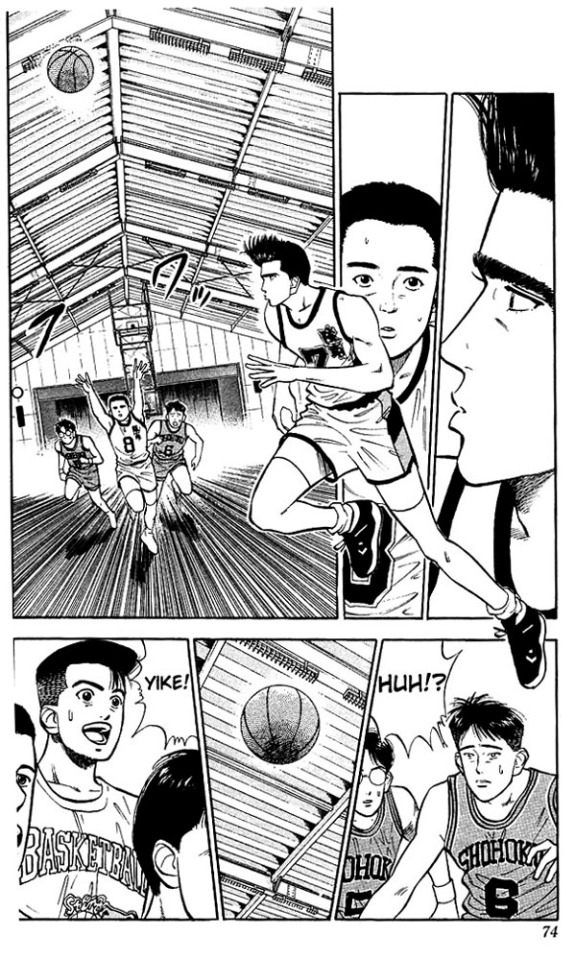
Here, #8 is passing forwards to Sendō. We see Sendō moving to intercept the ball as if from nowhere - he's in an extremely off-balance dynamic pose here helping communicate his horizontal movement, while the other players' movement is sold by the speed lines and passing poses.
Then we see the ball lingering in the air, with multiple reaction shots - something is definitely going to happen right? Turn the page and...

Sendō reaches up to catch the pass. More reaction shots - Sakuragi gets a much more cartoonish expression than every other character. By dragging this out across multiple panels and pages, we get a form of slow motion, extending the tension. but then!
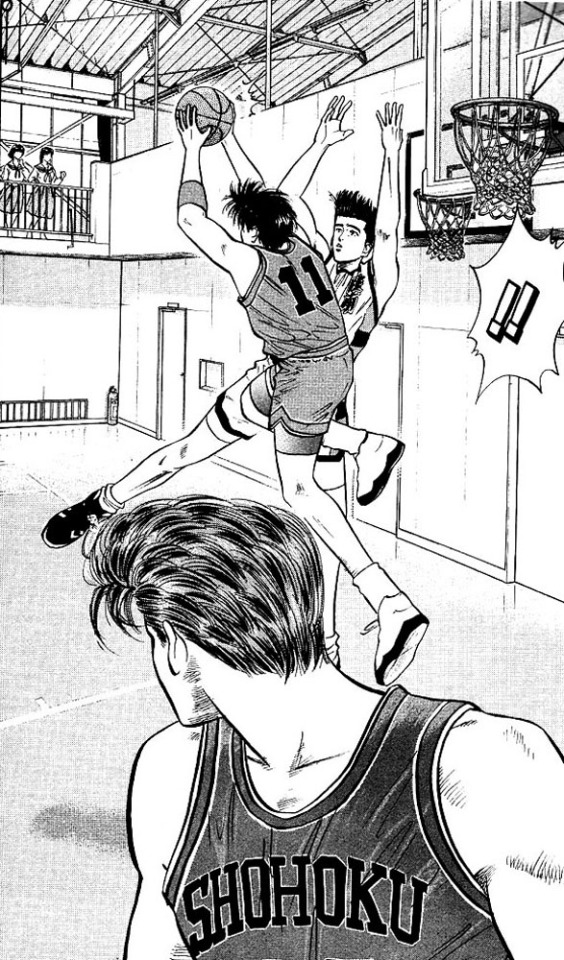
Rukawa intercepts! This full-page spread is pretty much a mirror of the shot at the start of this post where Rukawa was receiving the pass. We also have Sakuragi in the foreground, his neck twisted at an extreme angle to show his surprise.
This panel has a very detailed background. For these big splash panels, Inoue generally goes to one of two extremes. Either it's a super detailed background like this, which accentuates the sense of a moment frozen in time, or we get pure negative space:

Look at this! The pure white bg puts the emphasis on the silhouettes; the composition as a whole has a fantastic diagonal flow. Sendō is stretched out, Rukawa is compact. Sendō's hand shows where he thought the ball was going, but our eyes follow the line down and roll along Rukawa's arm and we see he's actually passed it to the side.
Also note how the characters' hair is all fluffed up by the motion, and the zigzag shapes in the clothing.
Inoue can 100% mix up the camera angles too. For example...

We're shooting from above here, a tricky angle to draw, but the speed lines convey the sense of a rapidly tracking camera like you might get in a sports broadcast.
You can see this exact approach to composition in The First Slam Dunk. As a film, it adds a bunch of extra tricks to the arsenal with camera movements, slow and fast motion and the like - but the way the players move is structured in much the same way, with the slowmo taking the role of these big splash panels.
Honestly, reading this manga, I'm not surprised that Inoue did such a great job directing a movie of his work. He has an extremely cinematic style already: a lot of these panel sequences translate very directly to a sequence of shots in a film. I don't know yet if TFSD is directly adapting sequences from the manga or if it's just Inoue applying his tried and true tricks to a storyboard instead of a comic, but either way, it's very impressive.
Basketball has the advantage that there is extensive video of people playing it that you can study to get a sense of how they move, but I think this manga would be a great study for anyone drawing action scenes in a comic...
10 notes
·
View notes
Text
[Loading…]
[Transcript Begins.]
[Two silhouettes are in the direct view of the camera, vaguely outlined by the light of a flickering television screen. One is smaller, and angled towards a small device, whilst the other appears to be detracting themself from their companion. The taller turns out to be speaking, seemingly at their compatriot]
?: Hey. Hey. I– listen, I… it’s–
[Voice identified: Cassius.]
[There is no sign of a reaction from the figure, only a determined stare at a screen invisible to the lens of the camera]
C: Will, I– do– how– fuck, I’m awful at this.
[Cassius reaches out to tap the other person on the shoulder.]
[The person's demeanor completely changes, grabbing Cassius' hand, and twisting it 180 degrees. It looks at Cassius, with a distantly violent stare.]
?: Don't. Touch. Me.
[Voice identified : The Archivist/William Keane]
C: Sorry– I. I don’t know how to– Jesus that hurts– how do I help?
TA: They killed him. They killed him.
[Cassius glances between the TV and The Archivist. Breathing heavily.]
[His arm is released from The Archivist's grasp, not before a familiar, mechanical crackling is registered. It can almost sound like a growl, if one was to describe it.]
C: [Whispered.] Oh, god.
[The being stares at the opposite person, seemingly keeping watch for any movement. The crackling hasn't stopped, but has came to a low hum, permanent but quiet enough as to not attract much attention]
C: I– I know they did. And I’m sorry. I want to help. Please. Just…
TA: Can't..leave.
[The Archivist's voice cracks, the humming pausing in its methodical whirr. He sounds..almost sad.]
C: What? No, I’m not leaving. I just want to know how to help you before you do something dangerous.
W: Don't..know.
[William's Voice is strained, as if it was in pain as they spoke. His hand appears to be curled tightly into a fist, the skin appearing to have something red dripping from it.]
C: I know I’m not the best at comfort, and… I can’t… bring him back. But I’ll try. It probably won’t be any good.
[The being's head tilts, seemingly listening. It's posture hasn't changed, still in the position he was in before.]
C: I think I… know how you’re feeling. A little. I uh. Told you about… my sister. Right?
W: Mhm..?
C: When I found out about my parents plans, I was angry. I was so full of rage, that I didn’t even see what I’d done to them for at least a minute after I did it. And I didn’t notice that she’d seen me do it. It was a stupid choice, and someone who I cared about ended up dead. I think someone has already gone down that path, Mari. They just murdered a random employee. A very stupid choice if you ask me. But they’re not smart anyway, so–
[The mechanical whirring has begun again, The Archivist letting go of its fist. The monster growls and darts forward, bashing straight into Cassius. It's jaws lock onto wherever they could reach, and rends that piece of flesh away from his body.]
[Cassius shouts, a mix of genuine fear and pain. He is unable to say anything.]
[The Creature almost pauses, letting out a more humane cry of its own, before the whirring proceeds louder, almost deafening. It grabs at his left leg and bashes it, before tugging at it like a weed.]
[Another shout, this time accompanied by words.]
C: WAIT–
[There is something Whispered to Cassius by the creature, just before it pulls off the majority of his limb.]
[Cassius attempts to push it away from him, but he fails. His strength rapidly leaving him by the second.]
[The Archivist stands, staring at the man on the floor, before stamping on Cassius' chest with its metal leg. There is a sickening crunch picked up by the camera.]
[The man twitches once or twice, before all movement halts.]
[After a couple of minutes, the creature's behavior changes. William drops to the floor beside the man, seemingly in shock and distress. There are some hand-movements by the individual, but they don't seem to know where to begin. It starts to cry, kneeled in the steadily pooling blood of his recent victim.]
[Transcript ends.]
[Posting...]
7 notes
·
View notes
Text
I finished the four episodes of 180-degree Longitude Passes Through Us that are out and I don't think I can contain within me everything this drama has made me feel today.
It's something about how the show is so aware of the space it’s taking. Whether it's in the setting of the house in a quiet village or as a drama that exists in today's reality. Most of the show has been set inside In's house, but there's always an acknowledgment of the village that's beyond. An awareness of the people that live there, a responsibility towards them. It partly comes from its characters (mainly In, who is always 'paying attention' to his surroundings), constantly reminding us of the reality beyond In's house - the produce grown by the farmers around, the creek that the villagers need to cross etc. This also keeps up with In trying to make his point about the world not really belonging to anybody.
Extending this to Wang's perspective: unlike In, Wang's awareness is more about discovery. I'm a sucker for all the shots of the trees, the leaves, the sun that gleamed through them, the shots of his footsteps as he ventured into the woods and potentially changed the course of their lives, all of which adds to his bold and youthful nature. Inthuwat 'meticulously' following his coffee-making ritual spoke experience, while Wang quietly observing him spoke newfound curiosity and awe. He once mentioned that he felt lousy when he saw how careful In was in everything that he did. Couldn't be further from the truth. He may be all over the place with his actions, but damn if he isnt always paying attention to everything/everyone around him. That boy is perceptive to an almost fatal degree. (re: “You don’t like challenges. You only like challenging people” ahh this line said it all)
In contrast, Wang's mother who seems to be absolutely out of touch with reality, or maybe someone who is desperately trying to escape it. Her sense of superiority over creating het lakorns as opposed to (the supposedly mainstream) BL dramas is almost funny because she is a BL drama character herself,,, she is just so unaware of her place. She sounds loud and carefree but it’s evident that she has chosen to live in a bubble that protects her son and herself, but mostly just herself. I pity her. Making her a lakorn director obsessed with romantic fantasies was a genius choice and brings me to how the drama itself is so aware of the space it's taking in the Thai entertainment industry. All of the debate on the escapism that the industry (with its reliance on tropes) provides versus the reality of the modern day. Escapist media isn't a bad thing at all, but of course, a balance in the type of content created is always great. Everything about the show screams an intent to stay grounded in reality.
And while I talk about the awareness of the show's writing, the same can be said about the camera. The shots are able to present us with the histories of the characters. It understands who the characters are at their roots and their relationships with each other, beautifully highlighted by how they've been staged. The cinematography is simply fantastic. It’s rare to have a BL drama that is this assured of how it wants to present itself. The beauty of the shots does not only come from the visual appeal but also in the purpose they fulfill, which is difficult to do for a seemingly simple concept.
Many of its qualities are unlike a thai drama, and this too seems purposeful. But I can't say for sure. I looked up the director/screenwriter - Punnasak Sukee, and turns out he is an acclaimed theatre director, with credits for various plays including Midsummer Night's Dream and the Rocky Horror show, in addition to several original plays (the titles of which sound hella interesting) and this is his only screen credit at all. It explains a lot.
Honestly, I don't know how they plan to lay out the next four episodes. Given the age gap and character dynamics, I'd be surprised if it has a happy ending. I think they're aiming for something bittersweet. It would be fitting. I don't know if it will be satisfying, hurtful, disappointing etc. But I know that I'd still cherish it for the state it exists in currently. Really, the only thing I wish for is for the characters to heal.
I'm nowhere near finished, there's a lot to unpack, but this is already all over the place, and if you've read this far thank you and sorry. I'm just so happy that it exists at all.
#180 degree longitude passes through us#and its awareness#unleashing thisss#meta???#i get that the angst and/or age gap may not be for everyone#but this one may be worth it#the angst comes from several places#the story has so much heart in it#the whole vision is intriguing#and i cant wait it to see it all laid out#and it pains me to see it not being talked about enough#180 degrees longitude between us#GAH im not going to be normal about this NOO#edited for hyperlinking
63 notes
·
View notes
Text
What makes the movie even more astonishing is the fact that Isabelle Adjani couldn't look ugly no matter how much she tried; she's so heart-achingly beautiful that it can get confusing what to feel about Anna and her actions. She is absolutely terrifying in her most bizarre scenes, even more so because of how ravishing she looks even while screaming herself raw. It seems she can turn insane eyes on and off like a switch, her pupils seeming to dilate on command. There were scenes where she's taunting men with a devilish smirk and blood-churning pools of hatred in her eyes. And then there were 180-degree turns where she's just standing there almost slack-jawed, face wiped of emotions, her gaze into the camera turning hypnotic after a guttural outburst literally seconds before. This is an incredibly taxing performance where words can't adequately express all the emotions the character is feeling, so her body has to do most of the talking.
Absolutely stunning work by one of the best actresses in the industry. Shame she's not more recognized outside of France. Her body of work is beyond admirable.
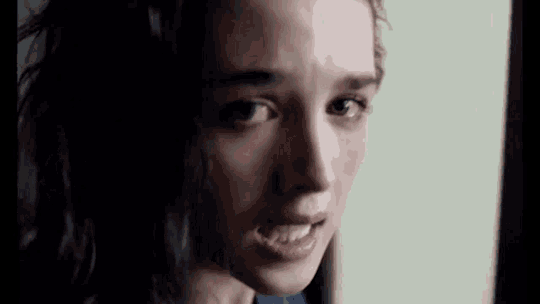
3 notes
·
View notes
Text
Basic Filming Rules Part 2: The 180 Degree Rule and Spatial Orientation
A large part of many movies is dialogue between two characters. It can be very intense, it can be playful, it can be romantic...it can be many things that help the plot progress forward. One thing that cinematographers (and even playwrights) have discovered is that the audience prefers to be on one side of the interaction space wise. It feels like you are standing or sitting in front of the conversation while the scene plays out. It helps the viewer to feel secure in how each character is oriented. If you were sitting at a table, then focusing only on the character on the left means they should be looking towards the right of the camera, while looking at the person on the right means they should be looking to at the left side of camera. It makes logical sense to the eye spatially. To keep this phenomenon of visual orientation in balance, there is a basic rule that filming should be done from one side of a straight line made up by the eyeline of the characters who are interacting. Below is a very basic example from a google image search:

The arrows represent different camera angles and exemplify that the camera can be almost behind the subject and the orientation won't change as long as the shot is taken over the correct shoulder. Changing to the other side of the subjects will suddenly flip the orientation and it seems very weird. It would be like sitting at a play and watching a dinner scene, when suddenly the stage is rotated 180 degrees and you are now seeing the actors from the other direction. It would be very strange. This comforting orientation concept can be seen in films as simple as Bill and Ted's Excellent Adventure (1989), where Bill is almost always on the left and Ted is on the right.



Orientation consistency is pleasing to the eye and the 180 Degree Rule retains this during a scene, so the audience knows (quite literally) where each character stands.
Using Positional Orientation to Help Tell the Story
One of my favorite movies is The Princess Bride (1987), and part of the fun is that battles to the death are treated like very intense conversations. The hero is involved in fencing duals, games of wits, and even wrestling with a giant. These are very extended fight scenes, and the conversation goes on throughout. For this reason, orientation is used along with the 180 Degree Rule. The hero is the Dread Pirate Roberts, who is trying to steal back a princess that has been kidnapped (there is more to it, but I don't want to spoil anything). Roberts takes on a Spanish swordsman named Indigo Montoya and the two switch sides throughout. The continuity works, however, because the fighter with the upper hand tends to be on the left. There is a reveal that each fighter has been using their non-dominant hand to extend the battle, and each time the handicap is made known, then the two switch sides. At the very end, the victor is on the right and he purposeful walks around to the other side before delivering the final blow.

Breaking the 180 Degree Rule to Tell a Story
Another one of my very favorite films is a black and white comedy drama called Paper Moon (1973), and it stars real-life father and daughter Ryan and Tatum O'Neil. The film is about a man (a grifter) who promises to take a little girl to her aunt's house. There is some question about her being the grifter's actual daughter, but he seems to want to use the girl to swindle some people out of guilt money. The grifter convinces a man to give him $200 to take the girl and the little girl believes it should be hers. The movie is set in the late 1930's, so that amount of money would be around $4000 today. She wants that money, she just lost her mother, and this no-good drifter is taking her across country and will likely swindle her if she doesn't do something. They stop at a restaurant and get some food. The grifter is acting like a father figure and telling the girl what to do. The camera angle originates from inside the restaurant and has the two actors at the table as the focus of the shot.
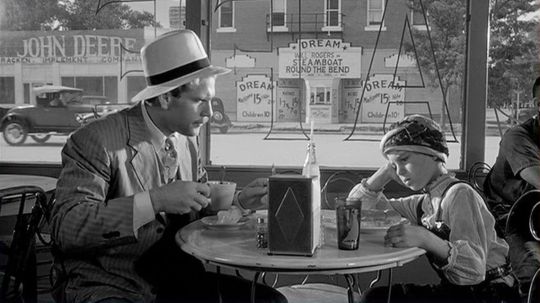
The man grabs some ketchup for the little girl, and she suddenly starts to complain loudly about her $200. The camera is turned 180 degrees and smashes the line to show the actors had switched positions and we are now more aware of all the other people in the scene. The depth of field extends back so the audience can tell that, despite the man wishing for privacy, the whole restaurant is listening to the conversation.

This is a power play by the little girl and this change in the balance of power is displayed by switching the sides of the characters. The tighter shot of the two at the table reflects the man's desire not to have others overhear the conversation, but the long depth of field implies that the other people in the bar can hear everything just fine. It is a brilliant sequence by director Peter Bogdanovich. Even more so, this whole film is extra special as he was advised throughout the production by his close friend and mentor, Orson Welles.
Breaking the 180 Degree Rule in a Bad Movie
I think that this is fast becoming my favorite aspect of these posts. I was watching the movie Catwoman (2004), starring Halle Berry, and the poor filming technique is disorienting throughout the run time. The film has a 9% Rotten Tomato score and took home many Razzies for being basically the worst movie of the year. The acting is just silly, the story doesn't really make sense, and the directing is laughable. I think the cinematography might be the worst aspect of the film (it is so hard to choose), mainly because director Pitof couldn't decide on a shot and just cut everything together in a massive jumble. There are constant circling shots, weird quick cuts, and sudden jumps with no explanation. One thing that actually gives me a headache is that the constantly circling camera crosses the 180-degree line often, so the viewer has no idea of what the spatial orientation is. There is a fight in a jewelry shop in which it makes some sense, but then it is done during a discussion in a boardroom, at the lead characters cubicle, at a little library, during a pickup basketball game, and even just walking down the street. It makes us constantly have to guess who each character is talking to, how the sets are laid out, and where characters are moving. Again, this might make sense in a fight since Catwoman is very quick and agile, which makes it confusing for her opponents. But there are quick cuts and circling shots that cross the eyeline that basically cause motion sickness. It feels like you are on a boat and the prop furniture is constantly shifting and re-orientating itself. Below is a gif of the inappropriate basketball game that has me looking for my Dramamine. This is not skipping around; this is how the movie was apparently intended to look.
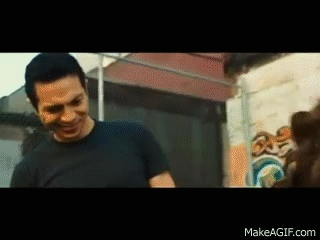
I see some dribbling of a basketball, so I am thinking it is a one-on-one match with these kids watching. Where are they on the court? Got me. Are the kids surrounding the area of play? I'm pretty sure, yes. I also am pretty sure it is half court with a wall on the side (although the camera might be located in the wall at some point?). From watching the whole scene, I believe that the woman (Halle Berry) has cat powers and is trying to attract the man (Benjamin Bratt) with her new skills and confidence. I think the circling is implying that man is changing his opinion about her or that he is confused...maybe? I shouldn't have to guess or make up my own story, the visual telling is the job of the director and cinematographer. This is a mess and an extreme example of crossing over the 180-degree line and destroying any semblance of spatial orientation.
----------------------------------------------------------------------------
Where actors are placed in relation to the camera is very important. This can be used to keep the audience calm and orientated to time and space, or it can be used to purposefully cause chaos and confusion. Subtle details in the shooting can help tell the story, or it can inadvertently confuse the audience as to what the heck is going on. No matter how it is used, spatial orientation and the 180 Degree Rule are good basic things to always keep in mind when filming.
#the princess bride#paper moon#catwoman#film making#camera tricks#film school#introvert#bill and ted
20 notes
·
View notes
Text
Best fisheye lens 2022
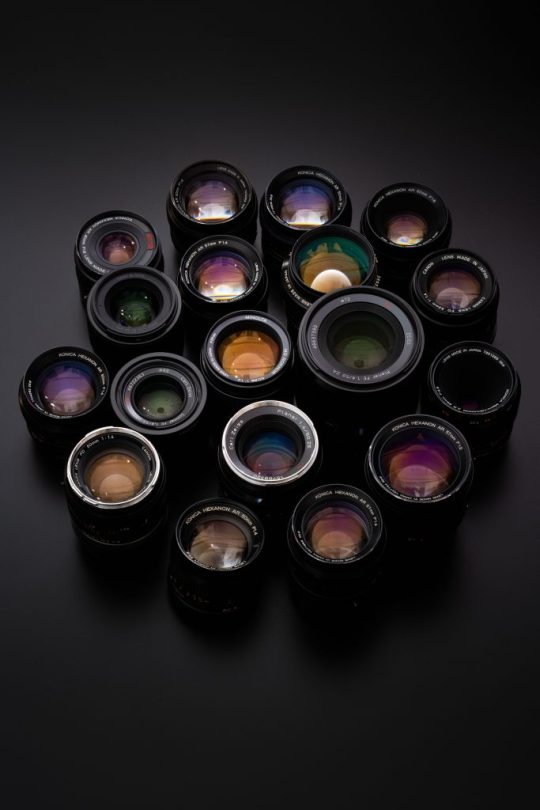
Introduction
You've probably heard about virtual reality (VR) by now. It's been huge lately, and it doesn't seem to be slowing down anytime soon. VR has a lot of potential uses, from entertainment to education to business. But what is VR, exactly?
VR is a type of technology that allows you to experience a different reality. It works by creating a completely immersive environment that you can interact with. You can see, hear, and feel everything around you, as if you're really there. This makes it perfect for things like training and education. You can learn faster and more effectively in a VR environment than you could any other way.
But that's just the beginning. VR is also being used in the medical field, for things like surgery and rehabilitation. There are even plans to use VR to help people with anxiety and other mental health issues. VR has the potential to change the world, and we're just seeing the beginning of it.
What Are the Best Fisheye Lenses on the Market?
You're probably thinking, "What the heck is a fisheye lens?" Well, let me tell you.
A fisheye lens is a type of ultra-wide angle lens that gives you an almost 180-degree view. This type of lens is perfect for VR because it offers an immersive experience that feels more realistic.
There are a few different fisheye lenses on the market, but not all of them are created equal. So, what's the best fisheye lens on the market? Here are a few of our favorites:
1. The Canon Fisheye Lens :
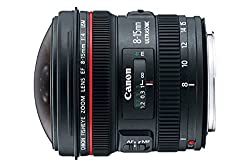
- Advanced Optics For Professional Imaging
- Quiet And Fast Autofocus And Low Light Performance ,
- Built For Professional Performance
- Max Focal Length: 15.0
- Read More
2. The Nikon Fisheye Lens

- Widest NIKKOR fisheye Lens yet and the first with zoom capability
- Capture EPIC 180 Degree circular images and traditional frame-filling fisheye images
- Close focusing up to 0.5 inches from your subject for macro-style fisheye images
- Weather-sealed design and Nikon protective fluorine Coat for use in harsh conditions
- Equally suited for still photography and video work
- Read More
3. Opteka 6.5mm f/3.5 Professional Ultra Wide Angle Aspherical Fisheye Lens
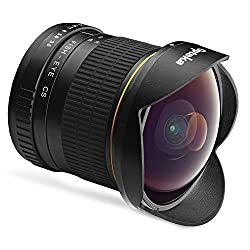
- EXPANSIVE 180 DEGREE VIEW
- HD SUPER MULTI-COATED OPTICS -
- CONSISTENT AND SHARP IMAGES
- DURABLE HEAVY DUTY CONSTRUCTION
- COMPATIBILITY - Can be used on all Canon EOS APS-C cameras including 90D, 80D, 77D, 70D, 60D, 50D, 40D, 30D, 20D, 10D, 7D, Rebel T8i, T8, T7i, T7s, T7, T6i, T6s, T6, T5i, T5, T4i, T3i, T3, T2i, T1i, SL3, SL2, and SL1.
- Read More
The Future of VR With Fisheye Lenses
Imagine being able to step into a completely immersive virtual world. With a fisheye lens, that's now possible.
This technology is the next big thing in VR. It creates an incredibly realistic experience that's so immersive, you feel like you're really there. Fisheye lenses are perfect for creating a sense of depth and making you feel like you're part of the action.
The possibilities for this technology are endless. It's already being used in medical training, for example, to help surgeons learn new procedures. And it's also being used in military training, to help pilots prepare for real-world scenarios.
The future is looking very exciting for VR!
Conclusion
You've probably heard about virtual reality (VR) by now. It's been a huge topic of discussion in the media and in the business world over the past few years. But what is VR, exactly? And what can it be used for?
VR is a digital technology that allows you to create a completely immersive virtual environment. You can explore this environment, interact with its inhabitants, and even learn new skills in it. VR has many uses, from entertainment to education to business.
One of the most interesting aspects of VR is its potential for training and education. VR can be used to speed up training for things like fighter piloting or surgery. It can also be used to teach people new skills in a safe and controlled environment. VR has the potential to revolutionize education as we know it.
Whether you're interested in VR for entertainment, education, or business, there's no doubt that this technology is changing the world as we know it. Keep an eye on VR – it's only going to get bigger and better in the years to come!
Best Fisheye lens under $200 Click Here
Read the full article
2 notes
·
View notes
Text
The Raid 1 (2011) and 2 (2014)
A swat team storm a building but the criminals within are ready for them. The most skilled fighter on the team then pits himself against several crime syndicates each with an agenda of their own.
The action is the main selling point for this film because there are huge portions of each film where the dialogue fades away and full focus is given to complex and engaging fight sequences. There are points where they seem choreographed more like dances than fights but the brutality quickly restores the context.
The sequel was very different from the first installment, with only a few elements consistent, fortunately they are fairly important ones. It’s confusing because there are so many factions all fighting each other so one must work out which fighters are police, the Japanese gang, the Indonesian gang, the usurpers, or others. There’s also about an hour of set-up in the second film whereas the first one got stuck into the action right away.
The consistent elements helped a lot, like having the same main character and even bringing his family back to keep his motivations the same. Both films have deeper character relationships than would be required for a standard action film, almost every notably character has something about their background revealed.
Some of the characters, particularly in the second film, have a considerable build-up but not much of a pay-off which is a little disappointing but at least adds variety. The hammer and bat henchmen in the sequel are the best example of this; both get full scenes to establish them but are defeated in a short time.
The Raid: 6/10 -Just a cut above average-
The Raid 2: 4.10 -It’s below average, but only just!-
-The protagonist combines many styles of martial arts including Judo, Karate, Tae Kwon Do, and more.
-Rama’s codename in the sequel is Yuda which sounds similar to Judas who betrays Jesus in the bible.
-Lighting was made difficult in the scenes which required 180 degree camera turns to special lights on poles were used.
4 notes
·
View notes
Video
youtube
Ratchet & Clank Part 7: In space no one can hear you scream bloody murder
(The first half of the video has no audio because my pc was being obnoxious, playing the audio from my perspective but not letting the program record it and I realized it too late. Sorry for that)
Oh boy here we reach Gemlik Base!
It’s long, it’s tough, it’s pretty damn unforgiving
Don’t take this as a negative though, I actually quite like this place, especially due to its atmosphere, what with it taking place mostly in space and that music
My only issue with it is that near the end it forces you to fight a huge room full of enemies. If you remember I said that this game’s weapons and controls are just not all that suited for direct engagement and this is one moment where I feel the game forgot about this. It feels like something straight out of Going Commando and beyond but without the key mechanics to make it not awkward to manage, especially with the camera not really focusing on the enemies
This is also where Ratchet completes his “character arc”....if you can call it that
Ok so it’s pretty obvious that the game wants to present Ratchet’s story as that of someone who initially only really cares about his own selfish interests, only to eventually be swayed into becoming a full blown hero thanks to Clank, who acts as a sort of moral compass to him. On paper this is good
In practice it’s very halfassed for a number of reasons
The first one being that, like Ratchet said in a previous video, we don’t know him. The game tells us absolutely nothing about him as a person or what he usually does on Planet Veldin, the most we know is that he’s a mechanic and he presumably wanted to explore the galaxy in search of cool stuff to see which is why he was trying to build a spaceship at the beginning. This helps to explain his initial behavior throughout the first act, where he’s essentially a pretty easy going dude who’s mostly just following Clank along for the ride, but is easily distracted by stuff like wanting to participate in hoverboard races or being made into an official hero by Captain Qwark
Then Clank almost has them both killed when he walks into Qwark’s trap and from then until now Ratchet pretty much switches to a completely different character. He’s super spiteful towards Clank, keeps saying the meanest shit to him and suddenly becomes obsessed with getting revenge against Captain Qwark to the point that he flat out states multiple times that he doesn’t care if Drek keeps destroying planets so long as he gets to Qwark. Not only is this a complete 180 from what he was at the beginning it’s also pretty damn unwarrented
I can get being initially pissy at Clank for his naivete, but Ratchet literally holds this grudge until the last act of the game, even though the game makes it pretty clear that Clank is just naive, mostly due to the fact that he was only recently built and doesn’t have much experience with the world. This doesn’t feel like Ratchet having a volatile attitude, this makes it look like he’s a childish prick who flies off the handle for the flimsiest of reasons
And while him being mad at Qwark for double crossing him makes sense the dude gets obsessed to such a forced degree! I almost expect him to bust out a giant sword while screaming his name to the clouds, you’d think he’d killed his parents with how mad Rathet is at him, while Qwark is just some guy who happens to be a famous superhero who turned out to be a conman.
And after all of this now Ratchet suddenly flips the switch again. After he sees Drek’s newest plan for destroying a planet he suddenly starts having second thoughts about this and after finally dealing with Qwark he goes “yeah I’ve been a jackass, let’s go save the galaxy!”, which makes no sense because EVERY planet in this game has been attacked by Drek in some way, yet Ratchet never cared, not even at the start before he got all pissy, yet only now does he switch into responsible hero mode, without it even being some kind of gradual slow change brought about by Clank’s positive influence, hell Clank at some points even says “This is not you Ratchet!” when he acts like a dick and even goes “This is the Ratchet I know!”, which is stupid because they’ve known each other for very little time by this point and even at the start of the game Ratchet wasn’t that heroic to begin with!
I know that many fans hate how Ratchet has had his attitude mostly stripped away from him in later games from what little I know, making him blander. That’s not good, but this goes too far into the opposite extreme and feels far too much like flat out sloppy story telling to me. I’m also sure that’s how the devs must’ve felt back then because, from what I know, Ratchet’s personality was one of the game’s most criticized aspects back when it released, so much so that for the sequel they largely rewrote his personality to be way friendlier and even gave him a new voice actor in order to further drive home the idea that this was a “new” Ratchet.
1 note
·
View note
Text
KEEPER - Pitch Deck Contribution
Cinematographer’s Statement - Alex Caldow
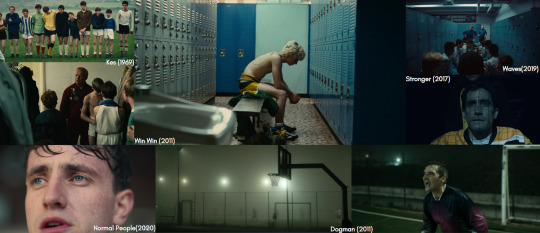
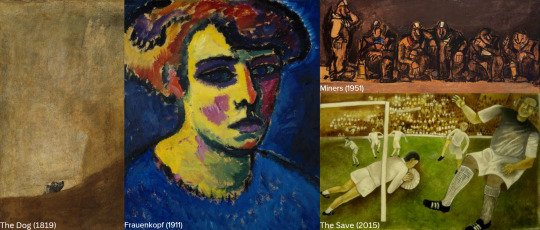
Visual References
The designing principle for KEEPER’s visuals is that the audience should see and feel only what our protagonist sees and feels. This is the best way to understand the stakes and the psychological pressures that directly affect the narrative.
We see everything from Will’s perspective, through over-the-shoulder shots, close-ups on his reactions and direct POV’s. One departure from this view is the wide shots of Will at the times when he is totally alone and feeling that way. He is small and his dreams are big.

Inspiration still from Win Win (2011)
Because, on top of seeing, we also want to be feeling. Will is coming into the trials with a lot of passion but with that fear of failure, of not being good enough, lurking in the back of his mind. We want to be able to feel this energy and desperation so one aspect of the visual style is the use of tight shutter-angles. We want to begin at 90 degrees, minimising motion blur, to mimic Will’s heightened awareness. He doesn’t miss a detail, everything is crisp, hyper-real. (This technique is used in the opening of Saving Private Ryan to a similar effect, however, our film will not be utilising hand-held camera-work). But then, after the trial, after he’s had his hopes dashed, we come back to the more traditional 180 degree shutter-angle, to reflect his snap back to reality.
Also playing into Will’s hyper-awareness is the use of wide lenses. I’ve tested the University’s set of Zeiss Ultra Primes and found the 24mm to offer the correct field of view for the character with minimal warping at close distance. This lets us see everything that Will is taking in in his wide-eyed anticipation: the many moving bodies in the changing room, the expanse of the pitch and the relationship between Graham and his players. The wide lenses also give us more room to play with blocking and composition in the tight space of the changing room. However, as the stakes rise and Will’s focus hones in on Graham’s expectations of him and the performance of Aaron, his competition, we move onto longer lenses. Again, from my tests, I have found the 50 and 85mm lenses to be my preference to communicate this feeling as they don’t compress the depth too much, allowing us to still place the details within the space.
Although Will is hyper and full to the brim with adrenaline, he is still very controlled, as is the environment. Following this idea, I have chosen to shoot the film without any handheld camerawork. However, the film also focuses a lot on the motion and action of the characters, so I will be relying on extensive dolly moves. This is not just to allow us to stay in Will’s perspective as he moves, but also to emphasise his encroaching tunnel vision during the trial, as we push in on details, such as the ball being placed for a penalty or Graham blowing his whistle.
The film’s world is meant to feel realistic, if brutal and intense. The night-time, open field setting allows me to create stark, high-contrast images that isolate our character, almost creating a non-space, like in Under The Skin (2013), where the pitch is all that exists for Will, the rest falling into darkness.
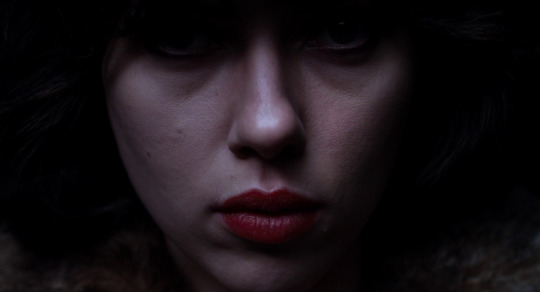
The dark void in Under The Skin (2013)
To create a naturalistic feel with the lighting, I want every source to feel motivated by the space. This means that a lot of the scenes will be top-lit, motivated by the floodlights on the pitch or the overhead bulbs in the changing rooms. Will’s bedroom has a very different feel: warm lighting that contrasts with the cool lights of the sterile club environment. This makes Will seem even more out of place at the club. Then, when he returns and the space is lit by the cool moonlight spilling through the window, we see the way that the club has transformed his whole world to feel hopeless and cold.
Another focus of the film is the relationship between Graham, the coach and Will. Graham wields his power over Will brusquely if not maliciously. To emphasise the power imbalance in their relationship and prioritise Will’s perspective on this, we always look up at Graham, shooting from below his eyeline. The effect that Graham’s presence has on Will’s psyche and playing ability is also shown by using deep framing throughout the training sequences, keeping the form of Graham always in the frame, always in Will’s mind.
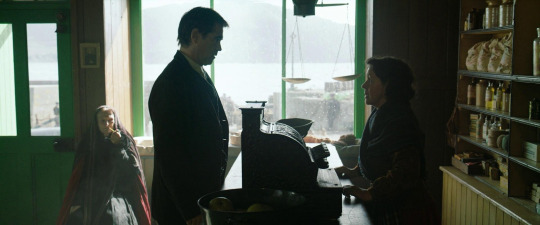
The old woman as a looming presence in the background of The Banshees of Inisherin (2022)
Having the visual approach tied down to Will’s character and the world of the film, it creates a cohesive, punchy experience for the audience as well as giving me a guiding principle that will help me problem-solve on set and improvise shots.
Main Equipment Needs
To achieve the planned look for the film, we will be shooting on the Arri Alexa (precise model still to be decided) with the Zeiss Ultra Prime lenses. We will also need to be using a dolly and long lengths of track. For the outdoor, night-time scenes, we will need battery powered LED lights - specifically the University’s Nanlite Forza 300s and Kinoflo Celeb 250 DMX. In order to keep focus during the fast-paced dolly moves, we will also need access to the Tilta Nucleus-M Wireless Follow Focus.
While these are our main needs, we are making sure that we find locations quickly so that we can best find ways around any issues that arise and book equipment to solve those problems.
0 notes
Text
Popular 3D Scanner, Polycam, Uses AI to Complete the 3D Picture
Polycam, the most popular scanning app on the Apple store—and perhaps in the world has found an ingenious way to use AI in its scanning. Polycam users will be able to create a totally immersive view with the ease of creating a panorama. The normal process for getting an immersive view involves moving the camera up and down while rotating, what another iPhone-using scanner refers to as a “painting the wall” approach. But Polycam is able to take the panorama and guess the rest, as it were.
You can get a full 360 degree view of an outdoor scene in less than a minute.
Polycam uses a process it has named “stable diffusion complete,” which is based on “stable diffusion,” the technology similar to one used by media sensation, DALL-e, to generate fanciful pictures, except stable diffusion uses your computer rather than the cloud. To use stable diffusion, users must have a GPU and 8GB of VRAM. While DALL-E and stable diffusion generate images, inpaints and outpaints (more on that later), Stable Diffusion Complete appears to generate a picture based on the image itself, essentially guessing what the rest of the sky or ground would look like, and turns what is normally a low-resolution thin strip of images stitched together and puts you in the center of a full resolution, 360-degree view about the vertical axis (that’s the yaw axis if you are flying a plane), where you can also have a full 180-degree up and down view (the pitch axis).
Meeting Elliott
If Elliott Spelman, cofounder of Polycam, doesn’t strike you as the typical Silicon Valley startup founder, it’s because he is not. Spelman is a designer by education with a master’s in fine arts from Stanford. Being at the helm of a cutting-edge imaging technology is fun for Spelman.
Out for a spin is Elliott Spelman, cofounder of Polycam.
Spelman wants scanning to be fun for everyone—not just professionals with expensive LiDAR rigs. We watch Spelman’s short instructional video that demonstrates how simple it is to take a full 360-degree image.
Sure enough, that is all that is needed to record a full 360-degree immersive image. Polycam may have ruined panoramas forever. After seeing the big picture that Polycam can create, a breathtaking sky-to-ground and all-around seamless (almost) shot, could you ever go back to a thin, distorted, low-resolution image you got from Apple?
How?

Polycam creates this magic with AI, explains Spelman in a Teams meeting. We expect no less from a company with AI in its domain name.
Although several 360 imagers have the ability to create a high-resolution immersive view (e.g., Matterport, Envisioneer, Luxolis), all of them require that your camera view includes the sky and the ground.
I take it out of the office for a spin. Polycam uses the full resolution of the iPhone’s camera and its image stabilization to take a series of pictures on its own as I rotate in place. The images are uploaded and Polycam returns with what at first looks like any other picture taken with an iPhone. And then you press on the image with your finger, and lo and behold, it’s a full 360-degree, immersive image. Polycam has added a fake sky and ground. It’s pretty good fakery. You have to squint to see where reality stops and fakery starts. The ground below is an excellent guess at what would be underfoot—without me having to extricate myself from the picture.
The stitching together of images in the 360-degree sweep is not perfect—though, in all fairness, that may be Apple’s imperfection. It’s a rare overcast May day in the Bay Area and the sky looks darker suddenly from left to right in one place. But overall, the result is impressive and the process effortless. The scan took less than a minute. I didn’t have to wait more than a minute for the processing. Studying the image, I see that tilt has been magically added to the pan. The sky and ground were completely filled in.
“It’s called inpainting,” says Spelman.
Outpainting would be more appropriate, but okay.
How well does it work inside? I ask.
The AI has its limitations, Spelman admits. It can create ceilings, but it may have trouble in the Sistine Chapel.
Should you, though? There are only a million pictures of the Sistine Chapel’s ceiling, snapshots shared on Instagram, for example. In fact, Autodesk was able to create 3D models of the statues destroyed by the Taliban from publicly available photos on Google. Surely, your AI could use photos similarly?
Spelman tolerates impertinent questions graciously. He could have reminded me that Autodesk has over 10 thousand employees, whereas Polycam has but 15. It is another sign that he is not your typical hyper, type A startup founder.
But the lightweight Polycam punches above its weight. Its reality capture is easier to use than Autodesk’s ReCap Pro. Instead of clicking away and taking photos, Polycam takes pictures continuously as needed all on its own. And it generates better images faster than the “pop-up” metaverse seen at PTC’s recently held LiveWorx conference.
Better Than LiDAR?
While having the LiDAR scanner in your pocket, as with the latest iPhones, is initially exciting, the lack of accuracy is somewhat of a detriment. Also, the images from the camera look better.
Responding to a less-than-favorable review of LiDAR scanning in our first look at Polycam, Spelman has a quick solution.
“You should have used the photo mode.”
It’s unexpected that LiDAR is less accurate than photogrammetry, but here we are, with the result of the iPhone, even the biggest one being too small for multiple, accurate LiDAR sensors, leaving the iPhone with plus or minus one-inch accuracy. Professional LiDAR systems, on the other hand, command mm-level accuracy.
Why not have professional quality LiDAR on Apple’s much larger iPad, I have to wonder.
About Polycam
Spelman and Polycam’s other founder, the equally boyish-looking Chris Heimrich, left a scanning company to create an app for simple, easy-to-use scanning. They have taken a page out of the Autodesk playbook, essentially democratizing a sophisticated process available to the elite. Anyone can take their smartphone and create a 3D picture with Polycam. And have they ever. The Polycam site (“3D capture for anyone”) gives them all gallery space.
Yet, Spelman insists that Polycam is useful for the professional. It outputs its LiDAR and photogrammetry data to standard formats—for example, DXF for AutoCAD.
It was the iPhone’s ability to store the images that made all the difference. Otherwise, there is too much lag in the shooting if you have to wait for each photo to upload.
Also, unlike every other startup, Polycam is now profitable. Polycam’s revenue model is simple, $79.99 a year for unlimited use. There is a free version, which has usage and export format limits.
The free intro. version encourages engagement, and the all-you-can-eat price promotes continued use. Other pricing schemes I have seen, such as price per square foot, discourage continued use.
0 notes
Text
Mise en scene
To deconstruct the Mise en scene of The Grand Budapest Hotel ,analyzed the scene in which M. Gustave first meets Zero and interviews him whilst walking through the noticeably lavish hotel into the elevator.
A noticeable part of M. Gustave’s noticeably formal and neat attire is the inclusion of a crossed keys symbol on the lapel of his jacket. It’s a prominent part of his costume and as well as simply being an interesting pin.
M. Gustave’s costume also stands out to the audience a lot more than other characters’ costumes. As well as purple, M. Gustave is also wearing white and grey which may show the audience that he has authority at the hotel. The character of M. Gustave is also a well groomed man which tells the audience that this character cares about his appearance.
Zero is dressed almost all in purple and his cap isn’t placed on his head straight and is instead positioned at a slight angle. This demonstrates that Zero is innocent and child like, and less organized and professional compared to the way in which M. Gustave is presented to the audience in terms of costume design. This presents a clear juxtaposition in character to the audience without dialogue; instead through mise en scene.
The set design for the exterior that we see at the beginning of this scene features a cobblestone floor. Snow is also featured on the ground establishes the environment and weather of the location for the viewer.
Cinematography
For the scenes taking place in the 1980s the aspect ratio is 1.85:1 and this is how the movie begins. Then we move back in time to the 1960s and the aspect ratio changes to 2.40:1.
The framing throughout the movie is consistent and very unique to Wes Anderson. I noticed a lot of symmetrical compositions and shots that are constructed to reflect the perspective of a specific character in a film.
Another interesting group of shots is the low and high angle shots captured with wide angle lens. They create a very specific point of view and are repeated many times throughout the movie
Camera movement
whip pans – one of the most distinctive camera moves known from the film. Most of the time it is used to change the view from one character to another. In Grand Budapest Hotel we can even see 180 degree pan between 2 characters on the opposite ends.
zooms – in critical moments we can see some extreme zooms to bring the audience right into action.
sideway dollies – oftentimes the character on screen is followed by the camera sideways.
tilts – coupled with wide angle lens it creates an extreme change in perspective.
panning during dialogs – Wes uses panning throughout dialogs scenes, end when he cuts, he usually uses straight-on and POV shots.
Editing
To deconstruct the editing of The Grand Budapest analyzed a scene that takes place in the 3rd act of the film.
This scene is predominantly a chase scene and therefore a lot of the time relies on the editing to create suspense for an audience. M. Gustave and Zero have returned to the prison after M. Gustave escaped from prison.
The most noticeable element of the style of the editing within this scene is how the cuts all line up with the rhythm of the non-diegetic compost score. Cuts will, most often, take place on the beat of the music. This gives the scene an exciting feeling and makes a lot of the time makes the audience engage with the characters more. Also, whenever there is an increase in tension in this scene, the amount of shots tend to increase as the shots become shorter in length. Less cuts makes for a slower paced sequence of shots.
Techniques like shot / reverse shot are often used but sometimes Wes Anderson will not use this technique in scenes and instead favors more extended, wider to shots to let conversations play out in like when Owen Wilson’s character greets Ed Norton’s character in a scene.
Sound
To deconstruct the sound of The Grand Budapest Hotel
The Remote Foothills scene where Willem Defoe’s character is holding an important piece of paper.
This scene starts with Willem Defoe’s character holding an important piece of paper whilst standing in a cold and high up location. This is demonstrated to the audience through the diegetic sound of wind blowing. diegetic sounds take place, there is a non-diegetic composed score playing over the top. score is suspenseful.
the camera pans over to see a young man standing next to a motorcycle, the sounds of the paper rustling reduces in volume and then the diegetic sounds of the motorcycle increases in volume to change the prominent subject from one thing to another using sound. This is a technique that Wes Anderson proceeds to use throughout the scene.
The scene transitions from one location to another, the cut is made all the more effective by the sounds that proceed and follow it. The score starts and stops at various points of importance on our characters’ journey, but for the most part, it becomes increasingly prominent the closer our characters get to the church and once the characters enter the church, the non-diegetic score becomes diegetic singing
Techniques/Patterns used
The most important three techniques that I noticed were lighting, color,depth of field and make-up choice technique. With the help of lightning technique, he showed the depth of emotions of the actor’s game. It is so sophisticated it showed that the viewer understands when a character is happy when he is sad or when he is at a loss. The scene where Zero begins to tell his story by being just starting to work at The Grand Budapest Hotel is a nominal scene where lightning techniques were excellent. In this scene, the camera directed to the Zero, and the back light changes making the whole picture interesting to the viewer.
The second important type of technique of Wes Anderson is depth of field. Wes Anderson subtly used this technique, which would change periods. The film begins with a young girl holding the book The Grand Budapest Hotel. this technique carries in itself rough transitions of time thus having made the film even more interesting.
Film analysis
The Grand Budapest Hotel follows a writer who is interested in the infamous hotel known as the Grand Budapest Hotel, which is no longer in its prime, and has since become run-down.
Pink colors are prevalent in this shot and throughout the entire film. The color scheme in this photo represents the unrealistic and dreamlike world in which the story of the Grand Budapest Hotel takes place. The hotel is a character of its own in this film. With the changing color schemes throughout the decades, the hotel changes just as much as the characters.
The main story is then set-up in which a writer is at the hotel and shares dinner with the current owner of the Grand Budapest, Zero Moustafa.
Once Zero dives into the tales of his youth, the real action begins to develop. Since the story has several different layers, from past to present, it is important to have a main storyline, which is introduced once Gustave appears on screen. Zero is hired by Gustave H.
The inciting incident is introduced when one of Gustave’s past lovers, Madame D, dies, and Zero and Gustave travel to the funeral.
When the Will of Madame D is read, a priceless painting called “Boy with Apple” is bestowed upon Gustave. This painting is one example of Wes Anderson’s form of pattern and auteur style, as he makes various references to art that play into the plot throughout the film.
As the movie breaks into Act Two, Gustave and Zero steal the painting and Gustave is accused and arrested for the murder of Madame D.The audience witnesses Gustave’s state in prison. This middle section of the film fully develops the B-story of the mystery of Madame D’s murder.
The midpoint of the story is reached as Gustave breaks out of prison, and the climax of Act Two is starting to come together. As Zero and Gustave meet with the butler who falsely accused Gustave, he is murdered by Jopling.
Act Two ends with Zero and Gustave chasing him down a mountain and eventually killing Jopling. Wes Anderson displays a unique camera style as the chase between Gustave and Jopling is sped up through frame rates.
As a stylistic auteur, Wes Anderson develops the story of Gustave H and Zero with precision through his symmetrical cinematography and uniquely beautiful set design. Grand Budapest Hotel is wonderfully executed movie.
0 notes
Text
The 10 Best Wireless Dash Cams You Can Buy Right Now
When it comes to it, there are many different approaches and viewpoints to consider wireless dash cam front and rear.
Driving is one of the most common activities people do on a daily basis, and for good reason. It’s an essential part of getting around town, and it’s also a great way to keep an eye on your car at all times. However, with so many cars on the road these days, it can be hard to find a camera that can capture everything you need without taking up too much space. That’s where wireless dash cams come in. In this article, we’re going to list the 10 best wireless dash cams you can buy right now. From small, discreet cameras to ones that can record in high definition, there’s something for everyone in this roundup.
What are the best wireless dash cam prices?
If you're in the market for a wireless dash cam, you have a lot of options to choose from. Here are some of the best prices for wireless dash cams currently available on the market:
The first option is the Foxeer C1 Dash Cam. This camera costs $69.99 and includes a 2-year warranty. It has a wide-angle lens that can capture up to 180 degrees of footage.
The next option is the SJCAM SJ4000G Wireless Dash Cam. This dashcam costs $119.99 and comes with a two-year warranty. The SJ4000G has an adjustable wide-angle lens that can capture footage up to 230 degrees.
The last option is the Panasonic Lumix DMC-TS5 Digital Camera with Voice Recorder (Black). This camera costs $269.99 and includes a two-year warranty. The Panasonic Lumix DMC-TS5 also has a voice recorder that can capture up to 120 minutes of audio recordings.
What are the best wireless dash cam reviews?
There are a lot of wireless dash cams on the market these days, so it can be difficult to decide which one is right for you. In this article, we'll review some of the best wireless dash cams on the market and help you decide which one is perfect for your needs.
We'll start by discussing the different types of wireless dash cams and what their advantages and disadvantages are. Next, we'll list our top five picks for the best wireless dash cam available today. After that, we'll provide a detailed buyer's guide to help you choose the perfect camera for your needs.
Let's get started!
The 10 Best Wireless Dash Cams
Looking for the best wireless dash cams to keep an eye on your vehicle in the car? Here are the 10 best wireless dash cams currently available on the market.
1. GoPro Karma
This camera is known for its rugged quality and its ability to take great footage in any weather condition. It also features automatic night vision balancing, making it one of the most versatile cameras on this list.
2. Samsung Gear 360
This camera is perfect for anyone who wants to capture videos or photos of their car in 360 degrees. It is easy to use and can be mounted on almost any surface, making it a versatile option for those looking for a wireless dash cam.
3. Sony FDR-AX100V
This camera is one of the most affordable options on this list and it still offers great quality footage. It comes with a built-in microphone so you can record audio along with your video, and it also has a long battery life so you won’t have to worry about charging it often.
4. DSMA Advantage X5 Mini Camera Kit
This camera is perfect for anyone who wants high-quality footage without having to spend a lot of money on it. It comes with a wide range of features that make it perfect for capturing cars in all kinds of conditions, and its small size makes it easy to store and transport.
5. Garmin Car Stereo Dash Cam HD (Available at Amazon)
0 notes
Text
Pic stitch for windows 10

#Pic stitch for windows 10 for mac os x#
#Pic stitch for windows 10 64 bits#
#Pic stitch for windows 10 pro#
#Pic stitch for windows 10 software#
#Pic stitch for windows 10 professional#
There are some features you’d miss if you stick onto the normal version of PTGui but the general scenario of features is impressive, indeed.
#Pic stitch for windows 10 for mac os x#
Available for Mac OS X and Windows, PTGui suits well for professionals as well as amateurs. PTGui is a blazingly fast solution you can depend upon when you need a photo stitching software with an impressive User Interface as well.
Price: Free Demo & Commercial Variants available.
It is available for both OS X and Windows.
#Pic stitch for windows 10 software#
In short, when you need an image stitching software that is simple enough, you can move on with Autostitch. To find matches between images, Autostitch uses the SIFT Algorithm.
#Pic stitch for windows 10 pro#
There is a demo version of the tool available, with lesser options, but you will have to go for the Pro version if you need features like Cylindrical and Planar projections. On the other hand, Autostitch can find matching sections of inputted images and proceed with the image stitching process. For instance, the first photo stitching software mentioned in the list wants you to choose matching points and then starts merging. Unlike those, you can use Autostitch to stitch photographs in the most effective way without any kind of input from your side.
Price: 99 Euros for Autopano Pro and 199 Euros for Autopano GigaĪutostitch is a bit different from other photo stitching software we have mentioned here.
If you want to really know the power of Kolor Autopano, you can check out the Gallery page, where you have a set of panoramic shots that are stitched using the tool. However, general features of Kolor Autopano include support for up to 400 input file formats, 7 export file formats and the ability to create both 360 Degree and 180 Degree Panorama shots by putting the least efforts. The latter variant offers additional features like masking tool & pre-stitching plugins. There are two variants of Kolor Autopano you can get - Kolor Autopano Pro and Kolor Autopano Giga.
#Pic stitch for windows 10 64 bits#
Kolor Autopano is a premium photo stitching software that is available for Windows (Windows 7, 8 64 bits only, ready for Windows 10), Linux Ubuntu 14.04 and Mac OS X 10.5 & later! In spite of the features it offers, Kolor Autopano comes with an extremely intuitive User Interface, which lets almost any user to complete the panorama stitching process in two steps.
#Pic stitch for windows 10 professional#
An extreme newbie and professional would find Image Composite Editor to be useful and that is what keeps it apart. Notable features of ICE are support for different kinds of camera motion, Gigapixel image support, the feature for exposure blending and the feature to automatically complete missing image parts like sky, clouds etc. Image Composite Editor is available only for Windows and it has support for Windows XP,7,8 and Windows 8.1. Also, there is an option to upload the multi-resolution output image to Photosynth site of Microsoft. Apart from combination of overlapped shots and the export to popular formats like JPEG and TIFF, Image Composite Editor offers support for Silverlight DeepZoom & HD View that are multi-resolution tiled formats. Image Composite Editor is the common name for Microsoft Research Image Composite Editor and it’s a project from Computational Photography Group of Microsoft Research wing. So, go for Hugin when you need a feature-rich and professional panorama software. User Interface of Hugin is not that tough, but you can get accustomed to it if you’re ready to take some effort. Other notable features of Hugin include its feature to correct shots that are wavy due to inconsistency of level, support for various projection types, advanced corrections, support for HDR Stitching etc. For instance, you can find control points and edit the parameters used so that you get the best output. It’s a fact that Hugin prioritizes customizability & advanced functions, and thus it’s more or less for professionals. Hugin is available for Windows, Linux and Mac OS X and it is being used by a large number of photographers when they need high-resolution panoramic shots. If these are set, we will just move onto the list.Īn open source initiative, Hugin lets you enhance your panoramic photography by combining overlapping images, as we said earlier. For instance, it’s rather necessary that all the images should have common exposure and that tripod level should be kept same during the capturing process. If you want to use the software, you should be a bit more careful while you capture. Don’t worry if you aren’t familiar with the term Photo Stitching - that is incredibly easier! In this post, we have a list of top 8 photo stitching software, which you can use for creating panoramic images that have enhanced clarity and resolution.

0 notes
Text
Gasping: For Patricia, stability and to some extent, life.
The movie opens with a scrumptious lady in focus on the newspaper. A man , in all his suave, is introduced as he roughs up the newspaper aside, an entry as normal as a side character. No hu ha, no heroic background.
The woman’s head turns in synchronisation with the train. The camera doesn’t stay on any character for too long. The focus is on everything and nothing at the same time.
Picture 1
Not minutes into the movie and we see a shot with foreground, mid ground and background
Extreme Long shots, wide shots, dissolve, close ups, are used vividly.
The car race sequence serves as the first example of how jump cuts are used infinitely in the movie, almost acting like a limb to serve the plot. The shaky camera, showing how it must be a hand held camera instead of a stabilized one, placed on the dent of the car, zooming in on the road to make the audience feel uncomfortable and know that this is how it feels to sit in a real car.
3 minutes in and the central character is already addressing and acknowledging the camera, breaking the most crucial rule of cinema, breaking the 4th well. But isn’t this what the French New Wave stood for.
At one point he says, the sun is beautiful and starts shooting with his gun in the air, showing just how, in his world, something beautiful will always be accompanied by violence.
He might be honest, too honest actually, but another character trait of his is he’s misogynistic. (They’re too ugly, Women are such coards behind wheels).
The camera traces his hands, his shoulders when he’s about to shoot at the police officer approaching. We never see him shooting directly at the policeman, just him falling onto the ground. Several jump cuts reveal the story in the most undiluted manner.
Even in between a conversation and the same angle, jump cuts are used as a technique.
Focus on the fact that the hero of the movie here is not an empathetic person, no remorse far from being perfect and almost narcissistic to a great extent. He doesn’t fit right into the whole ‘I am here to serve the society, be a friendly neighbourhood man’.
‘Live dangerously until the end’, a board reads.
The shot where Patricia asks Michael to take her to dinner, his answer is yes, but the reality is shown through the spare change he has in his pocket. His desperation to be with her, his deceit, his poverty, shown through just one shot.
When Patricia and Micheal are taking a walk to a restaurant, the people around are looking directly at the camera, at the actors, even stopping to take a good long look, yet again breaking the 4th wall, yet again showing how this is just a movie, and your suspension of disbelief is of no use here. Godard, the director, very purposefully violated the 180 degree rule in the movie many times, drawing the attention of the audience, saying, ‘look here, we are shooting a movie, and you should know that none of this is realistic.’
*during the car scene*
The juxtaposition of how that man is shown with no remorse about people in general, but when it comes to Patricia, he turns into this sad little lover boy who can’t live without her, or so he says. But that doesn’t stop him from bring rude to her.
The long apartment sequence showed us multiple painting in Patricia’s small room.
Noticed the mention of cowardice by Michel multiple times throughout the movie? He may say that cowardice is the most cowardly thing to do, but it seems like its all a facade. He is scared underneath. So much so, he needs to remind himself by constantly repeating it. With his hat, his goggles, the constant cigarette smoking, removing one only to put another shows he’s trying hard to settle in the idea of a hero but failing miserably.
When Patricia is interviewing someone, and as the interviewee says, he wants to- die after being immortalised, she looks at the camera with the face of a realisation. What kind, we may never know. Patricia, from the beginning of the movie said that she cannot read what Michel as a person is. But in the end, the audience is left confused about what she believes in, what her true face is and whether or not she loved Michel (her reaction to Michel suggested otherwise of her decision to get him caught). She is unaffected by the fact that she is pregnant and whether Michel is the father. Patricia shows no emotion when she finds about that Michel is a murderer, or that he had a wife or he is known by more than one name. One could easily argue, that she is the villain of the movie. She uses Michel to assess whether her heart belongs to him or not, rather than siding with the right of the society.
The film has Jean-Luc Godard written all over it, yet again perpetuating that any movie under the French New Wave will have the director’s essence, their signature style of film direction and the fluidity of a poet’s pen.
0 notes